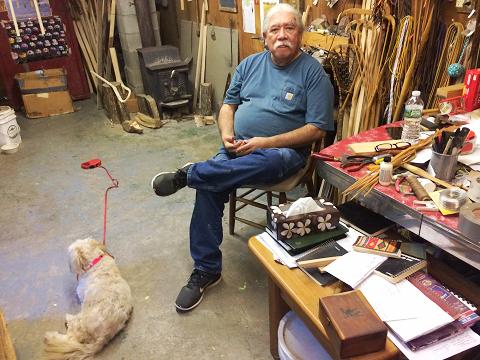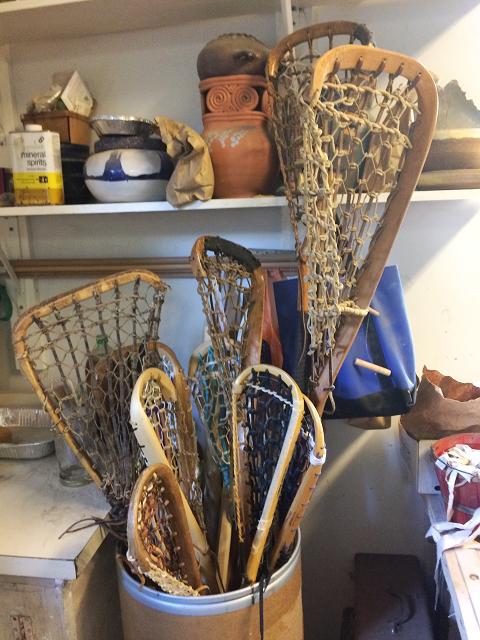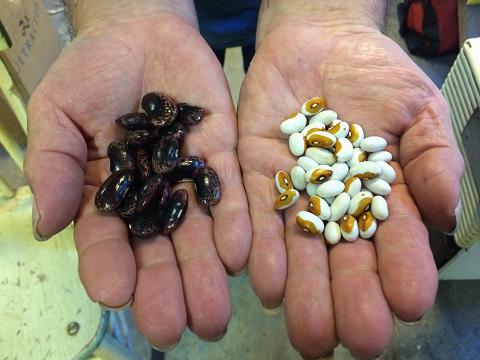 |
Canku Ota
|
 |
|
(Many Paths)
|
||
|
An Online Newsletter
Celebrating Native America
|
||
|
November 2016 - Volume
14 Number 11
|
||
|
|
||
|
Wooden Lacrosse Stickmaker
Gives Thanks By A Sacred Lake
|
||
|
by Sean Kirst - The
Buffalo News
|
||
People travel for miles to buy wooden lacrosse sticks they ordered from Alf Jacques. They drive Route 11A, through the Onondaga Nation, until they find his little shop beneath a hill, near the house where he grew up. Alf will hand them a stick, polished hickory shining like bone. He knows many buyers keep the sticks on display, and Alf always offers one simple piece of advice: “This stick was made to be used,” he’ll tell them. “Honor it. Make that stick happy and take it down sometimes and use it, then put it back on the wall.” Jacques, 67, is going Saturday to the Skanonh, the Great Law of Peace Center just outside Syracuse, for the Haudenosaunee Wooden Stick Festival. “He's a legend all over the world,” said Phil Arnold, director of the center and chair of the department of religion at Syracuse University. The center was created to offer a Six Nations perspective on their own history. It is on the shoreline of Onondaga Lake, where the longhouse people of the Haudenosaunee, or Iroquois Confederacy, believe their Peacemaker gathered five warring nations, and convinced them to bury their weapons beneath a tree of peace. Afterward, to show appreciation to the Creator, they played a game meant as thanksgiving. “The wooden stick is not just about the origins of lacrosse,” Arnold said, “but about the origins of democracy.” There will be Six Nations crafts, dancing and music at the festival. The event is built around wooden sticks and the ancient craft that goes into making them, which leaves Arnold to say this of Alf Jacques: “We couldn’t have it without him. It would be impossible. He’s a great educator. He knows how to talk to people. We want them to understand: This is a profoundly important game and it comes from here.” For Alf, it will be a day of renewal, of gratitude. In June, he lost his mother, Ada Jacques, to lung cancer. She was 87, but had always seemed indomitable. Every year, she tended to her garden, to the "three sisters:" the corn, beans and squash her people have grown and harvested for centuries. You would go to see Alf in his shop, and his mother would be outside the window, with her basket, in the garden. “She would always tell me patience is strength,” he said. “She’d say: ‘Alf, you’re a strong one.’” A month after her death, Alf noticed blood in his urine. He realized he’d been feeling unusually worn out. He went to the doctor. Alf learned he, too, had cancer. Within weeks, surgeons removed one of his kidneys. Alf rested for a while, but before long he returned to the shop.
“The most important thing is just to do things and to be here,” Alf said. There were family duties he felt he needed to perform. His sister Freida, an Onondaga clan mother, stopped by the other day to drop off Maggie, a 13-year-old dog who’s gone blind, a dog their mother rescued after it had been abandoned. Alf often looks out for the dog, while he works. He and his siblings still care for Ada’s garden, where aluminum tins catch the wind to frighten off the crows and deer. He grows as excited in talking about the garden – about the raspberries and beans that are such a deep part of Six Nations heritage – as he does in talking about the wooden sticks. “I build the fire and feed the cats and do things I've always done,” Alf said. “My mother is gone now, she’s gone to the spirit world, but she left us this knowledge to do, to carry on.” In that sense, he said, she’s still around - as is Alf’s father, Lou Jacques, who died about 30 years ago from emphysema. He and Alf, for years, worked side-by-side. The son still feels the father's presence in the rhythm of each job, in the long hours spent cutting and shaping each stick. From beginning to end, to do it to Alf's specifications, takes eight months. The wood needs to dry, to be just right, before it's ready. Alf has made lacrosse sticks since he was 13, when he was a boy who needed one for a school team. His family didn’t have the money to buy one. He and his father did it themselves, felling a hickory tree and dragging it to their house. They made a stick Alf used until he wore it out. His father, intrigued, pieced together all the skills he’d observed from old stickmakers at Akwesasne, the Mohawk territory where Lou Jacques was raised. The craft became a family business: At one point, decades ago, father and son were producing 12,000 a year. But the big companies figured out how to make plastic lacrosse sticks, and the great demand for wooden sticks was gone. Alf and his father kept making sticks, because many of the Iroquois used them in the box leagues, and an infant still receives a tiny wooden stick in the crib upon entering the world ….
While old men clasp carry wooden sticks to their chests in the casket, at the end of their journey, ready to play the game for their Creator. “I do it my way,” said Alf, of making sticks. “I’m not ready to change.” With the business diminished, he worked for years in a machine shop, and he’d play lacrosse and do his stickmaking at night. Prices vary, but each stick costs hundreds of dollars. He now makes about 200 sticks a year, as much as an act of love as for business. Alf is training an apprentice, Parker Booth, and Alf leaves it to Parker to find the trees and drag them out of the woods. They break them apart with axe and a mallet, and they use steam to bend the wood and form the sticks. Around the shop, in barrels or on the walls, Alf keeps weathered sticks made by long-gone craftsmen. His passion now comes from studying their work and trying to replicate it, or from experimenting: He is making a stick, for instance, out of elm, a far more difficult wood than hickory. Pilgrims sometimes come to watch in reverence as Alf works in his shop. He explains to them why he does it, the meaning of each stick, but the fascination remains a little baffling to him: “I’ve never done anything to try and be famous,” he said. “I’m just a stickmaker. That’s it.” And yet: Strength comes from patience, whether it is a garden, a lacrosse stick, or day-to-day existence. Alf grows “hegowa,” beautiful corn used in Six Nations ceremonies, the variety known beyond Six Nations territories as “Indian corn.” He keeps that harvest in open containers in his shop, near barrels filled with ancient wooden sticks, and he says all of it comes back to one central way of life:
For hundreds of years, he said, his culture has been under assault. His people lost much of their sprawling Upstate lands. There were attempts to destroy the language, traditions and faith system of the Six Nations. His parents taught him a great lesson, simply in the way they lived: Resistance is a long game. It lies in sustaining who you are, what you love, what you see as your true purpose. “You play lacrosse,” Alf said, “to say thank you to the Creator for providing the hickory trees, for the grass, for the sun, for the soil.” This autumn, Alf’s favorite season, follows a long summer. He lost his mother, then learned of his own cancer. He had the kidney removed and allowed himself a few weeks to rest. The doctors told him he would have a full recovery. By late August he was back in his shop, “because I’ve always thought if I stopped, I might never get back to it.” Saturday, with his lacrosse sticks, Alf will say thanks at the lake. Sean Kirst is a contributing columnist with The Buffalo News. Email him at seanpeterkirst@gmail.com
Great
Law of Peace Center |
||||||||
|
|
|
|
||
|
|
||
| Canku Ota is a free Newsletter celebrating Native America, its traditions and accomplishments . We do not provide subscriber or visitor names to anyone. Some articles presented in Canku Ota may contain copyright material. We have received appropriate permissions for republishing any articles. Material appearing here is distributed without profit or monetary gain to those who have expressed an interest. This is in accordance with Title 17 U.S.C. Section 107. | ||
|
Canku Ota is a copyright ©
2000 - 2016 of Vicki Williams Barry and Paul Barry.
|
||
 |
 |
|
|
The "Canku
Ota - A Newsletter Celebrating Native America" web site and
its design is the
|
||
|
Copyright ©
1999 - 2016 of Paul C. Barry.
|
||
|
All Rights Reserved.
|
||



